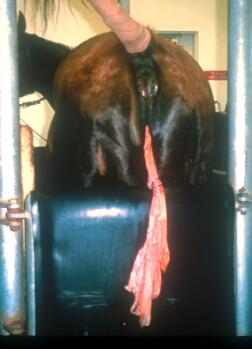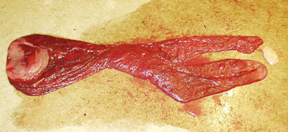Article
Management of Retained Placentas
By Patrick M. McCue, DVM, Ph.D.,
Diplomate American College of Theriogenologists
The placenta consists of the amnion, umbilical cord and chorioallantois. The amnion is a thin, transparent grey membrane that immediately surrounds the fetus. The umbilical cord connects the fetus to a thicker, velvety brick-red outer placental membrane or chorioallantois, that is attached to the uterus of the mare.
Separation of the placenta from the uterus begins prior to foaling and complete expulsion usually occurs within 30 minutes to 2 hours after foaling. Rupture of the umbilical cord after delivery of the foal causes collapse of the fetal placental blood vessels and subsequent shrinkage of the microscopic placental attachment sites. Uterine contractions post foaling in combination with traction applied to the outer placental membrane due to the weight of the amnion eventually results in release of the placenta from the uterus.
Retention of the placenta is one of the most common problems of the mare in the early postpartum period. A placenta is considered to be retained if it has not passed within 3 hours after foaling. The incidence increases following abortion, dystocia, obstetrical manipulations, cesarean surgery, induction of labor, placental infections, fescue toxicity and other factors. The percentage of broodmares that retain their placenta ranges from 2 to 10 %. Mares with a history of retained placenta have an increased risk of having another retained placenta in the future.
Mares may retain the entire outer placental membrane or only a portion of one horn tip following foaling. Detection of a retained placenta may not be obvious if only a portion of the placenta is retained within the uterus. The foaling attendant should examine the entire placenta once it has passed to determine if both horn tips are present. If the placenta is spread out in a 'Y' pattern, the tip of one horn will be noticeably thicker than the tip of the other horn. The tip of the thin placental horn is the one more commonly retained. It is important to emphasize that a mare may become just as ill if only a part of the placenta is retained as she will if the entire placenta is retained. Mares with a retained placenta may not exhibit clinical signs of illness in the first few hours after foaling. However, many mares become depressed, off feed and have an elevated body temperature if the placenta has been retained more than 12-24 hours. Rapid bacterial growth within the uterine lumen in the presence of placental membranes may lead to a toxic uterine infection and subsequently laminitis or founder. A retained placenta is potentially life threatening to a mare.
Strategies for management of a retained placenta vary with the duration of retention and the health of the mare. The initial treatment often involves administration of one or two doses of the hormone oxytocin to promote uterine contractions and expulsion of the placenta. If oxytocin therapy is not successful, a large volume of fluid may be infused into the cavity of the retained outer placental membrane to facilitate its release from the uterine wall. If the placenta remains attached, this procedure will at least have removed a significant amount of bacteria, endotoxins and debris from the uterine lumen. The oxytocin and uterine lavage treatments may have to be repeated several times until the placenta is passed.
Manual removal of retained placentas in mares is somewhat controversial. Manual removal has been associated with severe hemorrhage, placental tearing, delayed uterine involution, endometrial damage, intussusception of a uterine horn and uterine prolapse. It may be advantageous to initiate the medical treatments noted above before attempting to manually remove a retained placenta.
Additional medical treatments for mares with a retained placenta may include systemic antibiotics, nonsteroidal anti-inflammatory drugs (i.e. Banamine‚), and medications or management practices to prevent laminitis. Therapy should be instituted early, since complications can be severe and life-threatening. The prognosis for mares with retained placenta is generally favorable, but decreases if retention is prolonged or treatment is delayed. Foal-heat breeding is usually avoided in mares with retained placenta or prolonged vaginal discharge. Affected mares may be bred successfully on the subsequent heat cycle.
Horse owners and breeding farm managers are encouraged to examine the placenta after each mare foals. Treatment for retained placenta should be instituted early, since complications can be severe and life threatening. It may be advantageous to administer oxytocin to mares with a history of retained placenta within 1-2 hours after foaling. Mare owners should contact their veterinarian prior to the onset of the foaling season to discuss strategies for early intervention in the event that a retained placenta should occur. The future health of the mare may depend on it.
Figure 1. Photograph of a mare with a retained placenta
Figure 2. Photograph of a placenta. Note that both
horn tips are present. The hippomane, a soft, flat
mass consisting of placental cells and debris may
be noted adjacent to the horn tips.
About the Author...
Patrick M. McCue, DVM, Ph.D is Diplomate American College of Theriogenologists
Copyright © 2000-2012 Dupree, Inc.


Animal Reproduction Systems
800-300-5143







